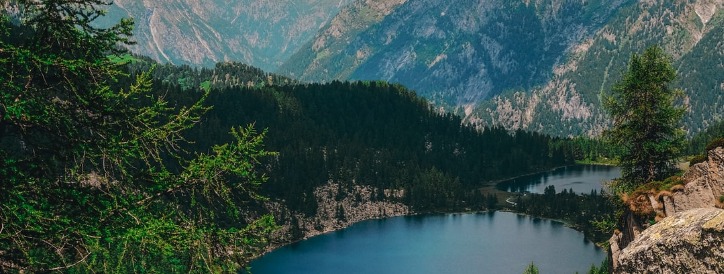The smallest region of Italy, on the extreme north-west of the country, Valle d’Aosta lies at the feet of the southern side of Mont Blanc / Monte Bianco; to the west facing the French border and to the north, the Swiss border. It also is the most mountainous Italian region, entirely surrounded by some of the best-known peaks of the Alps: the Monte Bianco, the Matterhorn, the Monte Rosa, and the Gran Paradiso.
Tucked into the north-west corner of Italy, the tiny region of Valle d’Aosta is fringed by the Swiss and French Alps, spreading over a series of deep mountain valleys. Home to the Mont Blanc (Monte Bianco) and Great St Bernard tunnels, Valle d’Aosta may be your first, or last, the sight of Italy as you travel between the Alpine region and its French and Swiss neighbors.
Skiing is, unsurprisingly, big business. Excellent resorts such as Courmayeur, Cervinia, Pila, La Thuile, and Cogne cater to downhill and cross-country skiers, and mountaineers, climbers and hikers. All are drawn by clean air, spectacular scenery, and excellent hotels and holiday villas. There are spectacular mountains such as Monte Bianco, Monte Rosa, and the Matterhorn; Roman remains; and fairytale castles which, in medieval times, defended this strategic entry to Italy. South of the lovely little capital of Aosta runs the Parco Nazionale del Gran Paradiso … Italy’s first national park (1922), and absolutely stunning.
Valle d’Aosta is bilingual, and there are dialects based on French and German. You’ll find road signs and menus in French and Italian, while the pretty Alpine chalets that dot the hills evoke Switzerland more than Italy
Of course, you may not even have heard of Valle d’Aosta, though it is well known to skiers. It’s the smallest of the Italian regions and is also the least populous. Packed within this small and almost exclusively mountainous region are Mont Blanc and the Matterhorn (and the Mont Blanc tunnel). And it has excellent winter sports at resorts like Breuil-Cervinia and Courmayeur.
Dual language, underpopulated and very much a crossroads … much of this is down to geography and history needless. Continental Europe is divided from Italy by the imposing barrier of the Alps. Even today, you can only enter Italy via a handful of tunnels through the Alps, such as the Frejus and the Mont Blanc Tunnels.
Aosta, Italy – Travel and Tourism
The regional capital and the only province of the Valley is a city rich in history.
Traces of the ancient Augusta Pretoria (the Latin name of Aosta) can easily be seen, such as the great Arch of Augustus (25 B.C.) and the remains of the Roman Theatre. You may visit the Cathedral Church of S. Orso, the castle of Fénis, built in the 12th century and, in the vicinity of Saint-Vincent, the location of a famous casino and a mineral water spa, the castle of Issogne with its richly decorated halls. Other castles you may visit in this area are the castle of Verrès, Graines, Cly and Aymavilles.
The natural landscapes of the Valley are fabulous with the mountains Mont Blanc and Cervino, Monte Rosa and the Gran Paradiso, the high mountain at the center of the huge Natural Park of the same name.
The Parco Nazionale del Gran Paradiso is Italy’s oldest national park, with its flowered meadows and small lakes; once the hunting ground of the Savoia family. Now it hosts large populations of marmots, chamois, eagles and stambecchi, a mountain goat.
The holiday towns and ski resorts of the Valley are long-established and well-known, like Courmayeur, Champoluc and Cervinia.
